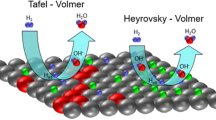Abstract
The dissolution of nickel in sulfuric acid (100 g/L) is studied by cyclic voltammetry using intermediate cathodic polarization between cycles. The main laws of the joint effect of the potential (from –2.0 to ‒0.2 V) and the duration (32–1800 s) of cathode pulses on the metal depassivation are revealed. Anode nickel oxide films are found to disappear during cathodic polarization of the metal as a result of simultaneous processes of reduction and chemical dissolution of oxides in the electrolyte.



Similar content being viewed by others
REFERENCES
S. F. Belov, V. A. Bryukvin, A. M. Levin, and O. G. Kuznetsova, “Dissolution of metallic nickel under the action of an industrial-frequency alternating current in sulfuric acid electrolytes,” Tsvetn. Met., No. 1, 39–41 (2005).
O. G. Kuznetsova, S. F. Belov, P. V. Ermuratskii, V. A. Bryukvin, A. M. Levin, and N. Yu. Frolov, “Comparative analysis of the electrochemical methods of processing nickel–cobalt-containing secondary raw materials under the action of ac and dc,” Tsvetn. Met., No. 2, 53–56 (2007).
L. P. Shul’gin, “Overvoltage of the electrode reactions in solutions upon passing of symmetric alternating current,” Zh. Fiz. Khim., 53 (8), 2048–2051 (1979).
L. P. Shul’gin, “Change in the thermodynamic characteristics of ac oxidation and reduction in solutions,” in Chemistry, Chemical Technology and Metallurgy of Rare Elements (Izd. Kol’sk. Filiala AN SSSR, 1982), pp. 119–126.
O. G. Kuznetsova and A. M. Levin, “On the depassivation of nickel under alternating current,” in Proceedings of International Conference on Innovative Technologies in Future Science (AETERNA, Ufa, 2017), Vol. 3, pp. 28–32.
A. V. Shein, O. S. Ivanova, and R. N. Minkh, “Influence of anions on the anodic dissolution of nickel silicide in a sulfuric acid electrolyte,” Zashch. Met. 44 (1), 38–44 (2008).
G. S. Bekenova, A. B. Bayeshov, A. Yilmaz, and H. S. Rafikova, “Electrochemical properties of the nickel electrode during polarization by asymmetric alternating current,” Sci. Soc., No. 2, 26–33 (2016).
A. I. Oshe and V. A. Lovachev, “Anodic oxidation of nickel in the potential range before the “main” passivation of nickel,” Elektrokhimiya 6 (9), 1419–1423 (1970).
J. R. Vilche and A. J. Arvia, “Kinetics and mechanism of the nickel electrode. II. Acid solution containing a high concentration of sulphate and nickel ions,” Corros. Sci. 18 (5), 441–463 (1978).
I. Garts, “Passivation of deformed nickel in sulfuric acid,” Zashch. Met. 15 (1), 29–33 (1979).
S. F. Belov, P. V. Ermuratskii, V. A. Bryukvin, A. M. Levin, and O. G. Kuznetsova, “Dissolution of the magnetic fraction of Bessemer matte unddr an industrial-frequency alternating current,” Tsvetn. Met., No. 2, 30–32 (2005).
A. P. Pchel’nikov, A. E. Kazachinskii, Ya. B., Skuratnik, S. A. Paprotskii, G. N. Markos’yan, A. I. Molodov, and V. V. Losev, “Method of determining hydrogen in metals and alloys,” USSR Patent 1779986, 1990.
V. V. Parshutin, “Corrosion and electrochemical behavior of pseudoalloys based on tungsten and its components,” Elektron. Obrab. Mater., No. 6, 27–45 (2008).
B. Mc Daugall and M. Cohen, “Mechanism of the anodic oxidation of nickel,” J. Electrochem. Soc. 123 (12), 1783–1789 (1976).
B. Mc Daugall and M. Cohen, “Breakdown of the oxide films on nickel,” J. Electrochem. Soc. 124 (8), 1185–1190 (1977).
A. P. Pchel’nikov, “Electrochemistry and corrosion of hydrogenated nickel, copper, and copper–nickel alloys in aqueous electrolytes,” Extended Abstract of Doctoral (Chem.) Dissertation, Moscow, 2006.
N. V. Gavrilova, Yu. N. Shalimov, and E. P. Kharchenko, “Prospects of using hydrogen in power engineering,” Elektrotekhn. Kompleksy Sistemy Upravleniya, No. 1, 60–65 (2008).
A. I. Marshakov, A. A. Rybkina, T. A. Nenasheva, and M. A. Meleeva, “Effect of atomic hydrogen on the kinetics of active iron dissolution. II. Methods of cyclic potential pulse and bipolar membrane electrode,” Kondens. Sredy Mezhfaz. Granitsy 14 (63), 349–357 (2012).
ACKNOWLEDGMENTS
This work was performed in terms of state task no. 007-00129-18-00.
Author information
Authors and Affiliations
Corresponding author
Additional information
Translated by K. Shakhlevich
Rights and permissions
About this article
Cite this article
Kuznetsova, O.G., Levin, A.M., Tsybin, O.I. et al. Effect of Cathodic Polarization on the Depassivation of Oxidized Nickel. Russ. Metall. 2018, 651–654 (2018). https://doi.org/10.1134/S0036029518070078
Received:
Published:
Issue Date:
DOI: https://doi.org/10.1134/S0036029518070078




